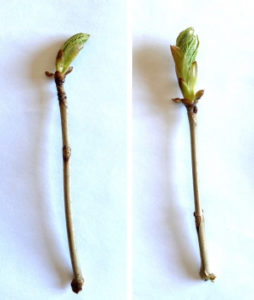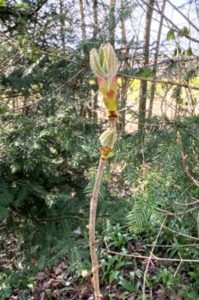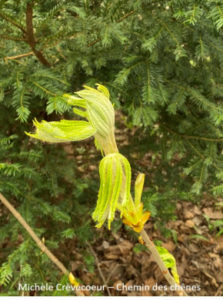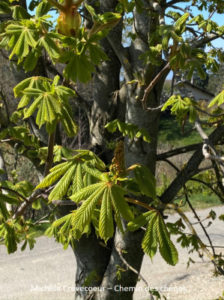Morphology: vegetative organs & particular categories of plants.
Numerous websites are devoted to plant organ’s morphology. You can find here some organ’s photographs linked to other pages on this website (anatomy, expertise, tissues):
(1) Buds and leaves: example of chestnut tree.
(2) Roots: example of corn’s primary root with links to pages devoted to adventitious roots and to pneumatophore roots.
Characteristics of plants adapted to particular environments are also illustrated.
(1) Xerophytes : plants living in dry conditions
(2) Hydrophytes: plants living in wet conditions
I. Vegetative organs
I.1. Buds
A bud can be vegetative, mainly made of very young leaves assembled around the vegetative point (meristem). It can also be floral and then contains primordia of flowers and/or inflorescences.
In numerous woody trees and shrubs species, the bud spends the winter period in a slowed down life state. They cease growth and enter in a dormant stage to survive to low winter temperatures. The buds are often protected (thermic and mechanical protection) by tough specialized leaves known as bud scales. These external scales are waterproof and covered with a sticky substance (waxy coat). Below them we can find thinner scales covered with hair. The whole system protects leaves, stems and/or flowers.
During spring the bud bursts and take back an active life. It begins to grow, with leaves beginning to emerge and a new axis (shoot) which is going to extend. Leaves are then going to deviate one from each other and acquire their definitive shape and length.
Some photographs of chestnut trees bud are presented here below at different stages of their spring budburst. During budburst we can have a vegetative bud or a floral bud. Photographs taken at Chemin des Chênes, Collonges Sous Salève, France in April 2020.Cha
The bud’s external surface (see on the right) is made of waterproof protective scales covered with a sticky substance (waxy coating). They ensure a mechanical and thermical protection.

I.2. Roots
The root system, most often plant’s hidden part, frequently represents a surface superior to the aerial part. Roots are real biochemical factories which can accumulate reserve substances exploited by human for its diet and synthesize complex molecules which often have a pharmacological interest. These molecules will be either transported toward aerial organs or secreted toward rhizosphere to interact with ground’s microorganisms (bacteria, mushrooms).
We distinguish the main (or primary) root, already in the embryo and which is then a root with an embryonic origin. We also call it seminal root.
Secondary roots are growing from the primary root or from another higher order secondary root, to provide a better support and help the plant to anchor in the soil in a more efficient way. They store sugars and other nutrients of which the plant will need subsequently.
Below is a photograph of a primary root (seminal) of Zea mays’ caryopsis. Some microphotographs of razorblade made sections from the piliferous zone are illustrated on another page.

Below on the right is a photograph of Zea mays caryopsis at the beginning of its germination with seminal primary root and its root hairs zone, adventitious roots (ra) and the coleoptile. On the left is a detail from seminal root’s tip with the root cap.
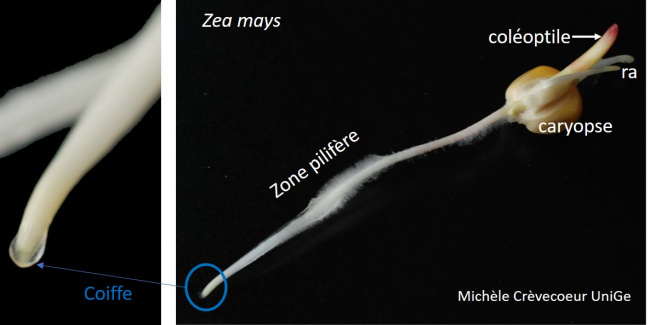
(1) the meristematic zone : mitosis (see DAPI and Feulgen stainings)
(2) the elongation zone : cells’ lengthening zone
(3) the differentiation zone : piliferous zone
(4) the organogenesis zone : beginning of lateral roots
I.3. Adventitious and modified roots
In addition to these primary and secondary roots, also called structure roots, we distinguish another category called adventive roots. They do not have a seminal origin and develop themselves on differenciated organs, most oftenly on stems.
Roots can also have morphologic adaptations to their environment.
Exemples presented on this website : pneumatophores roots, stilts roots and buttressing roots.
II. Characteristics of plants adapted to particular environments.
II.1.Xerophytes : plants adapted to environments in which water suplly is a problem.
II.2. Hydrophytes: plants adapted to environments in which water supply is not a problem
